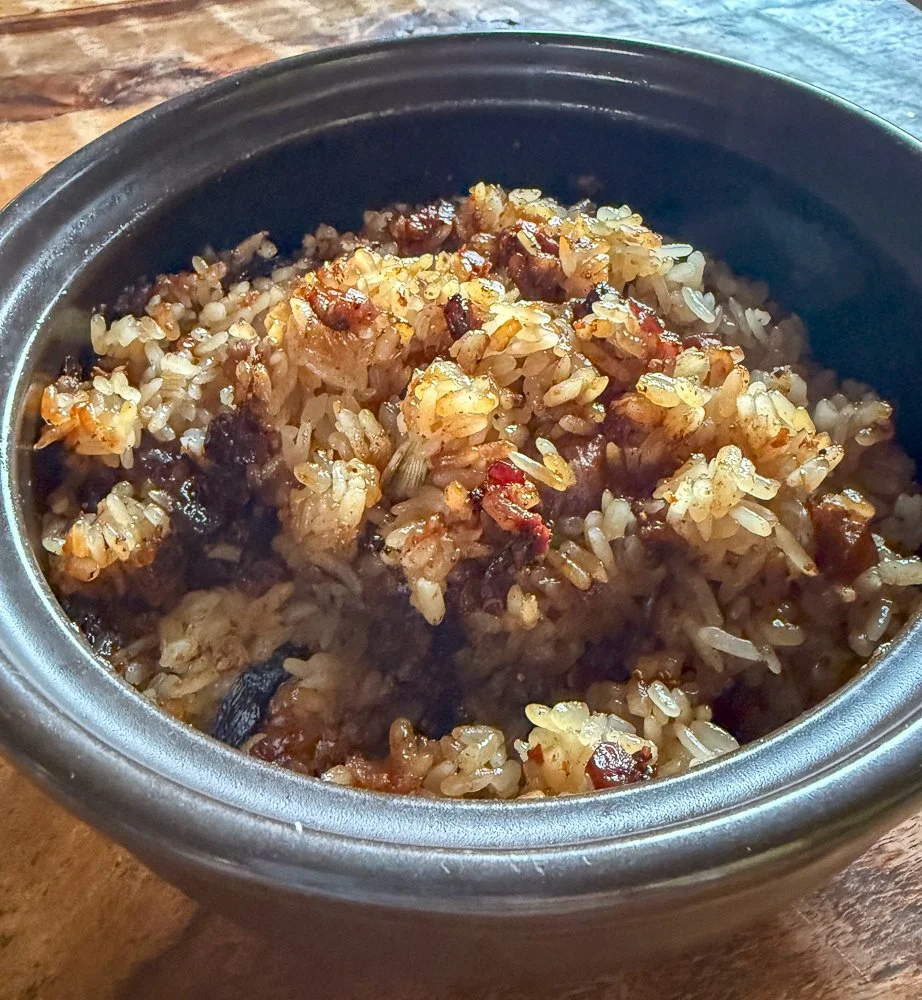Ayurvedic Kesari / Halwa
A Classic Indian Sweet, Reimagined
Made healthier, easier to digest, and more nutritious using Ayurvedic principles
Prep Time: 20 minutes
Cook Time: 40 mins (pressure cooker) | 1 hour (stovetop)
Serves: 4-6 as a dessert or snack
Ingredients
150g (3/4 cup) white sticky rice
50g white jasmine rice
10g (2 tsp) rose water (optional)
5g (1 tsp) vanilla extract
20g (~ large) dried jujubes (chinese red dates): de-pitted and cut into pea sized pieces
15g (1 generous tbsp) raisins
15g (1 generous tbsp goji berries)
10g (2 tsps) coconut sugar
13g (1 tbsp) ghee
1/2 tsp minced ginger
1/2 tsp finely ground true cinnamon (canela)
1/4 tsp finely ground cardamom
3 cardamom pods
2 pinches fine sea salt
1 pinch finely ground black pepper
Equipment
A steaming setup in a medium to large pot or pressure cooker
A heat proof pyrex glass bowl or clay pot to cook the rice in
Preparation
Place the sticky and jasmine rice in a small bowl and cover with 2 inches of cold water. Mix gently and the water will cloud up from residual starch left on the rice from the polishing process. Pour this off without anything of the rice coming with the water (called decanting). Repeat this process until the water doesn’t cloud up at all with a fresh addition of water, about 5-6 rinses.
Drain the rice in a fine mesh sieve and place it in your heat proof container that will fit in your steamer setup.
Add the water, vanilla, and rose extract and mix gently with your clean fingers to evenly distribute. Lift the container and shake it gently to even about the water distribution around the rice.
Tuck the whole cardmom pods into the rice
Add the jujubes, goji berries, and raisins sprinkling them evenly atop the rice.
Do the same with the ghee, ginger, ground cinnamon, ground cardamom, salt, black pepper, and finally the coconut sugar.
The rice is now ready to cook.
Cooking on the Stovetop
With your steamer setup, bring the water in the steamer to a boil with atleast 2 inches of water in the bottom. Place the rice in the steamer and cover with a tight fitting lid.
Turn heat down to medium, a heat level sufficient to keep the steam visibly billowing out from the steamer.
Steam for 50 minutes.
Uncover and spoon a bit of the rice out to to try it and make sure it is cooked through. If it’s still a little hard in the middle, steam a little longer until fully cooked.
Cooking in a Pressure Cooker
Set up your pressure cooker with a steamer trivet and a 1/2 inch of water in the bottom.
Place the prepared rice on the steamer trivet, cover, and bring to low pressure.
Pressure cook on low for 25 minutes.
Let it depressurize naturally and then serve and enjoy! If you’re in a rush, it should be fine to depressurize right away and eat.
Notes About This Recipe
This is my “fancy” Ayurvedic chef’s version of Kesari, but all you really need to make kesari is a starch, water, ghee, and a sweetener. If you don’t have all the ingredients you can still make a delicious Kesari by omitting any of the ingredient besides these four. They do make it all nicer though with a more balance and depth of flavor.
What’s Different About This Recipe
The most common type of Kesari is made with semolina flour and is quite good! Semolina is wheat based though, and wheat is denser and harder to digest than rice. I also made this Kesari to serve at an outdoor event, and wanted it to be easy to serve which which is why I chose sticky rice. I’m not sure if sticky rice Kesari exists in India, but it makes for a delightful variation because sticky rice is very dense and satisfyingly chewy. Other differences are:
When made with sticky rice, after is has cooled down you can roll this Kesari into bite sized balls that make for easy serving or snacks on the go
The addition of fresh ginger and little black pepper facilitate easy digestion of this dense sweet
The addition of several types of dried fruit deepens the flavor and makes it much more nutritious
The rose water, vanilla, and two types of cardamom + true cinnamon take the flavor over the top and also offer many health benefits!
Potential Variations
You could easily use many different kinds of dried fruit in this recipe to change it up, other ones I’d like to try are:
dates, figs, apricots, or sweet cherries
Be sure to cut them into small pieces, especially if you want to roll the Kesari into balls. If the pieces are too big, this will make rolling balls quite difficult if not impossible. If you’ll just eat it as is this doesn’t matter to much.
An addition of nuts would also be wonderful, I’d suggest:
Pistachios, walnuts, or skinned almonds
Be sure to soak these for 8 hours or overnight before adding to the Kesari, and as per the fruit above cut walnuts or almonds into small pieces if you want to roll the Kesari into balls.
Be sure to try this recipe out and let me know what you think!

